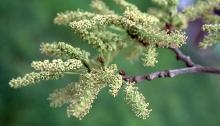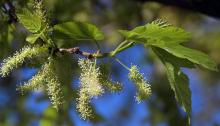Morus alba
Common name:
White Mulberry
Common Mulberry
Silkworm Mulberry
Russian Mulberry
Pronunciation:
MO-rus AL-ba
Family:
Moraceae
Genus:
Type:
Broadleaf
Native to (or naturalized in) Oregon:
No
- Deciduous tree to 50 ft (15 m) high, similar spread, round crown, young shoots downy at first but glabrous (without hairs) by autumn. Leaves alternate, simple, 6-12 cm long, broadly ovate, often 2-3-lobed with irregular clefts (sinuses), tip rounded to acute, base wedge-shaped (cuneate), truncate, or heart-shaped (cordate), margin coarsely coarsely serrate to crenate (rounded teeth), light green above, glabrous below except on veins; petiole 1-2.5 cm long. Flowers small, pale green, male and female in separate clusters (catkins), may be borne on the same or separate plants, bloom occurs in late spring. Fruit in clusters 1-2.5 cm long, green-white ripening pink to dark red, sweet but bland.
- Sun to light shade, adaptable, withstand drought and sea location, but grows best in moist, well-drained, fertile soils.
- Hardy to USDA Zone (4) 5 Native to China, leaves used in silkworm culture. It has naturalized through much of North America. Morus alba and M . rubra are both highly variable and are often confused. Both species have deeply lobed to entire leaves and are variable in pubescence. Some individuals are intermediate in leaf pubescence, suggesting the possibility of hybridization. (Flora of North America, www.eFloras.org).
- Morus alba has been listed as an invasive plant in some states. Birds, squirrels and other wildlife relish the fruit and are the major cause of its spread to native areas, therefore, fruitless selections are often recommended.
-
A number of selections are available, including:
- ‘Chaparral’ - fruitless, dwarf, weeping habit, often grafted to a standard to produce a tree that is 8-12 ft (2.4-3.6 m) tall and with a spread that is equal or wider and branches that droop to the ground.
- ‘Kingens’ - fruitless, 35 ft (10.5) tall, similar width, rounded crown.
- ‘Pendula’ - produces fruit, weeping habit, branches drooping to the ground, 15-20 ft (4.5-6 m) tall and similar width, some say it produces "interesting" shapes.
- ‘Striblingii’ - fruitless, deeply cut leaves, fast growing, 40-30 ft (9-12 m) tall at maturity.
- var. tatarica - known as the Russian Mulberry, considered the hardiest, USDA Zone 3 and 4 (Snyder, 2000).
- ‘Unryu’ - the Contorted Mulberry, a spreading shrubby tree with zigzag branches.
- albus: white











